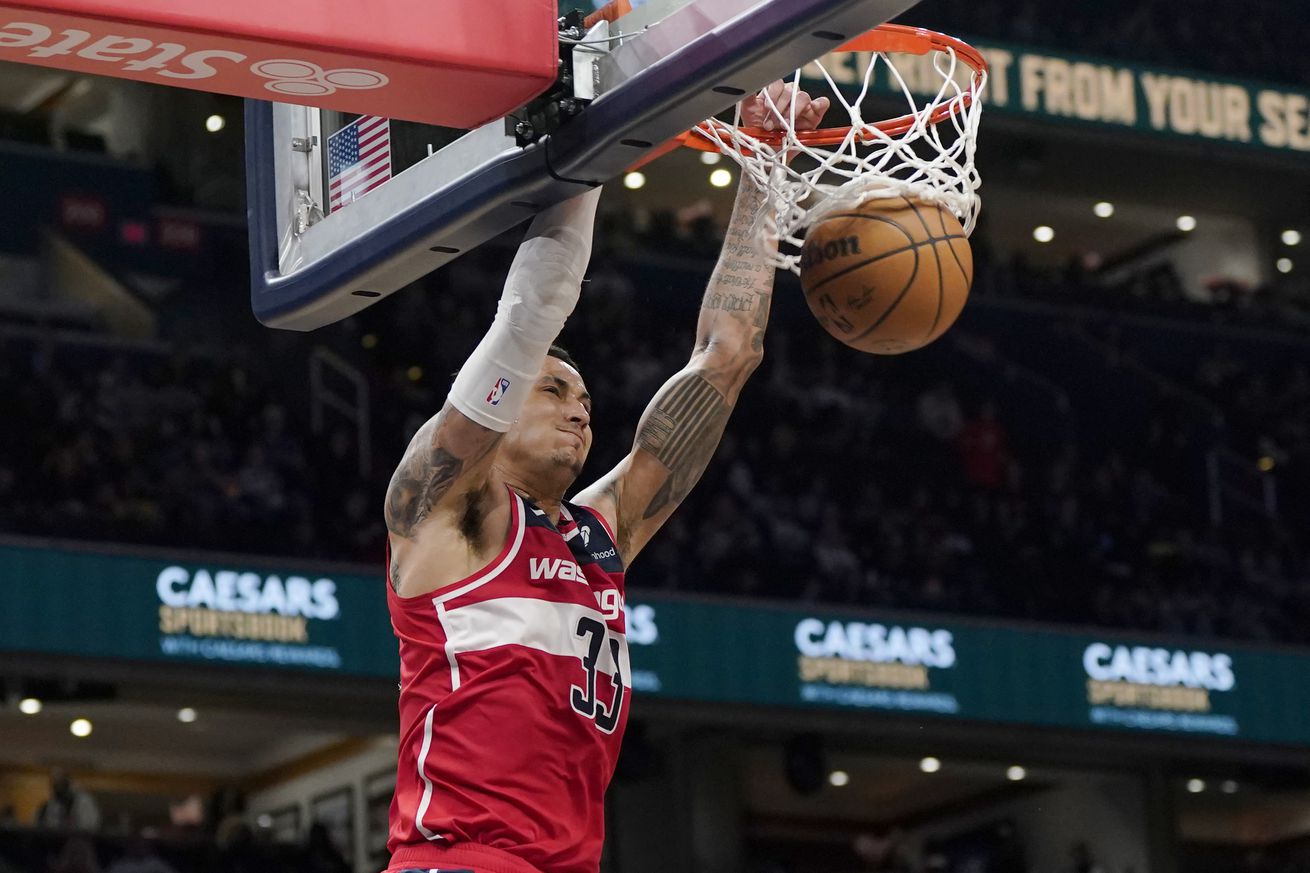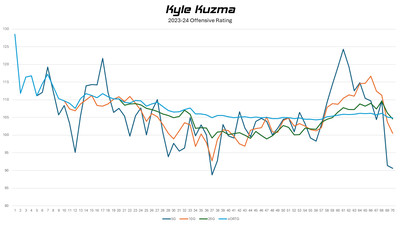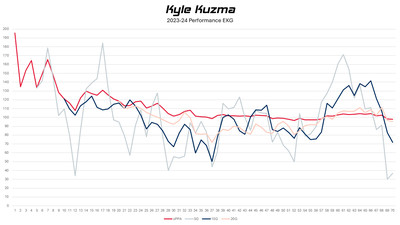
Stats, analysis, commentary on the Washington Wizards forward.
Last offseason, the new Wizards front office brain trust signed Kyle Kuzma to an eminently tradeable contract — four years, $90 million with another $12 million in potential incentives. The deal declines in value each season. They also gave him a 15% trade kicker, which — if he’s cooperative — would allow the team to dial his compensation to an amount needed to complete a trade.
They had an opportunity at the 2024 trade deadline to send him to the Dallas Mavericks in a deal that would have netted them a first round pick. The front office ran it by Kuzma, who told them he preferred to stay in Washington. While it was nice of Michael Winger and Will Dawkins to give Kuzma the option, they should not repeat the gesture.
In other words, trade the man.
This is not a criticism of Kuzma, who’s not a bad player. But he’s going to be 29 next season, he really hasn’t improved, and he’s flawed in ways that don’t help a rebuilding team very much.
We’ve played the “guess which season this is” game with Kuzma previously, so I’ll just list his season-by-season PPA progression. (PPA is my overall production metric, which is pace neutral and accounts for defense and role. The system rewards players for doing things that help a team win and dings them for things that don’t, each in proper proportion. In PPA, average is 100, higher is better, and replacement level is 45.)
- 2017-18, LAL, age: 22 — 89
- 2018-19, LAL, age: 23 — 95
- 2019-20, LAL, age: 24 — 59
- 2020-21, LAL, age: 25 — 98
- 2021-22, WAS, age: 26 — 108
- 2022-23, WAS, age: 27 — 95
- 2023-24, WAS, age: 28 — 98
Again, not a bad player — basically right around league average throughout his career. He likely hit his peak in his first season with the Wizards. At this point, he’s likely to maintain performance around average for another 2-3 seasons before he declines.
And the Wizards should have moved on long before that happens.
These numbers may seem odd if you’ve watched the Wizards on those nights when Kuzma has things going his way. Time travel him to a previous era, and he’d be amazing. He’s 6-10, mobile, has good ball-handling, and is a confident shooter. He has an array of scoring moves, a repertoire of flashy passes, and is sometimes a physical finisher on drives.
In other words, he’s big and skilled. That would seem to be the kind of combination that would make an outstanding player.
The problem? The size and skills doesn’t translate into putting the ball through the basket at a high rate, or into good playmaking for teammates. In other words, he misses shots and commits lots of turnovers.
This season, Kuzma shot 53.0% on twos, 33.6% on threes, and 77.5% on free throws. Each of those averages are below league average. He averaged 4.0 turnovers per 100 possessions, which was 25th most in the league. Now, he had good company in the 4+ turnovers per 100 category, including Nikola Jokic, Luka Doncic, LeBron James, Giannis Antetokounmpo, and others. However, among players with at least 4.0 turnovers per 100 possessions, Kuzma was tied with Zach Collins for second fewest assists per 100 possessions. (Karl-Anthony Towns had the fewest.)
Kuzma’s offensive rating (points produced per 100 possessions) was 105 last season — 10.4 points per 100 possessions below league average. Among the 51 players with at least 1,500 minutes and a usage rate above 25% (Kuzma’s was 28.5%), he ranked 45th. Behind him: Jalen Green, Russell Westbrook, Jaden Ivey, Jordan Clarkson, Jordan Poole, and Scoot Henderson.
The inefficiency is nothing new. Kuzma’s overall offensive efficiency has been below average every season of his career, even when playing with legends like LeBron James and Anthony Davis. Even when playing with quality offensive threats like Bradley Beal and Kristaps Porzingis.
Here’s his progression in relative offensive rating (individual offensive rating minus league average offensive rating):
- 2017-18: -4.6
- 2018-1: -5.0
- 2019-20: -9.8
- 2020-21: -7.7
- 2021-22: -8.8
- 2022-23: -12.5
- 2023-24: -10.4
For his career, his efficiency has been 8.4 points per 100 possessions below average. There’s still value in a player with efficiency at the lower end of Kuzma’s career range. It’s the sort of player who can lead a bench unit to a respectable enough offense that starters can rest.
As one of the team leaders or a top gun, it’s disastrous. Especially at the double-digit deficit Kuzma has produced each of the past two seasons. Last season, Kuzma ranked sixth from the bottom in points produced relative to average. That’s also where he ranked in 2022-23.
For the first part of the season, it looked like maybe Kuzma had figured something out. His offensive rating was 112 after 14 games, which was below average but in the -4 to -5 range that was still useful.
That was followed by a painful reversion to the mean. Over the next 20 games, his offensive rating was just 102. After that decent 14-game start, his ortg was 103 over the final 56 games.

The above is a kind of ekg of Kuzma’s offensive rating this season. Keep in mind that league average offensive efficiency was 115.3.
I’ve seen his backers argue that Kuzma’s inefficiency is the result of having to carry the load while on the floor with substandard teammates. The problem with that argument is the rest of Kuzma’s career — the inefficiency while playing with James and Davis or Beal and Porzingis. He’s been inefficient off the bench, as a starter, with average usage, and with high usage. There’s no reason to think that changes at age 29, even with a change of teammates.
In other words, the Wizards should get what they can and move on.
Below is Kuzma’s “performance EKG.” These ekgs track a player’s production game-by-game throughout the season. The red line is the player’s full season PPA after each game to that point in the season. The gray line is a five-game moving average, the blue is a 10-game moving average, and the pink is a 20-game average.

Observations
- Kuzma had a hot start and a decent stretch of games late in the season. In between? Rough.
- Kuzma had 11 games that rated 200 or better in my PPA metric, which is the average level of an All-NBA player and MVP candidate.
- He also had 10 games that had negative scores.
- In 18 of his 70 games played (26%), his production rated at or below replacement level.
- In my consistency index, Kuzma scored a 98. In my system, zero is perfectly consistent, and a higher score indicates greater variation in performance.
Here’s a quick comparison of Wizards players I’ve run through my consistency index so far (this will be updated as I continue with the offseason work):
- Deni Avdija: 78
- Kyle Kuzma: 98
- Corey Kispert: 104
- Bilal Coulibaly: 127
- Jordan Poole: 173
